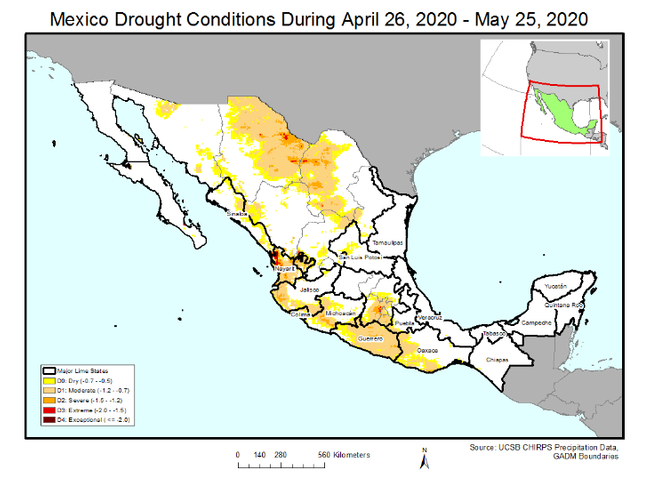USDA Report on Mexican Citrus Industry
This is a recent USDA report on the state of the Mexican citrus industry. It's interesting to hear how this industry is doing faced with HLB. And Drought.
Significant and ongoing drought conditions in many citrus-producing states have resulted in a reduction in all citrus production, compared to the previous report, with orange production forecast to fall forty-five percent. As a result of low orange supplies for processing, fresh concentrated orange juice exports to the United States are expected to fall to nearly half of the MY 2018/19 export level. COVID-19 sanitary measures are affecting domestic consumption of citrus fruit and juice, as many hotels and restaurants have been closed since mid-March. Full consumption effects will depend on the length of ‘stay at home' orders and the long term effect on the hotel and restaurant industries.
Drought and high temperatures
Orange production is estimated at 2,53 million tons for 2019/2020. That is 45% less than previous estimates. It is also the lowest expected harvest since the early 90s. This estimate is based on grower data and discussions with sector representatives.
The persistent drought and high temperatures have had a more drastic effect on orange production that other citrus. That is because many of the orange groves are older and need more energy to produce fruit. Many small farmers also lack irrigation technology. They practice bad pest control too, which compounds cultivation issues. Large-scale growers mostly have several irrigation mechanisms. They use fertilizers and apply other mitigating measures too. These include leaving weeds growing around the tree trunks. This retains moisture.
There have been intense temperatures and lack of rain throughout the growing season. That has resulted in a widespread decline in the orange's quality. Most fruit in the orange-growing region are smaller and of lower quality. In the state of Veracruz, October and November 2019 were the hottest months.
It usually rains throughout the growing season. However, this season, it was concentrated in two months. That resulted in a shorter growing season. The last flowering cycle indicates the harvest's end. This was between December and March. In Veracruz, oranges can usually be harvested until June.
Mexico is typically the world's second-largest producer of limes, and the fruit is the second-largest planted citrus crop in Mexico after oranges. While drought has affected lemon and lime production throughout the country, they have not been as affected as oranges. This can be attributed to newer plants and more widely available irrigation infrastructure. Persian lime trees in Veracruz are newer and more efficient, with 12 blooms, or harvests per year.The Post planted area for all limes and lemons in MY 2019/20 is forecast at 208,000 hectares, similar to previous MY; however, harvested area is expected to decrease eight percent due drought and high temperatures that caused some producers to abandon harvest or replant trees.
Italian lemons (Eureka) are grown in the states of Tamaulipas, Yucatan, San Luis Potosi, Colima, and Nuevo Leon. According to producers, there are currently attempts to grow the Italian lemon in the state of Veracruz with very good results. According to official sources, for MY 2018/19, production of Italian lemons was 131,469 MT on about 9,264 hectares. Sources indicate that lemon supplies for MY 209/20 are tight, and prices are high.
HLB
As with other citrus-producing countries, Mexico is facing issues with citrus greening, or Huanglongbing (HLB). The disease, caused by bacteria introduced by psyllids, makes citrus trees produce misshapen, partially green fruit (taste is typically not affected, but has no marketability for fresh consumption). Mexico's first detection was in 2009, and since then, the National Service of Agricultural Food Safety and Quality (SENASICA) has implemented a monitoring program for the disease. HLB has been detected throughout Mexico in citrus production areas. Producing states, including Veracruz, Tamaulipas, San Luis Potosi, and Nuevo Leon, have had HLB detections. In 2019, Baja California had HLB positive detections along the California/Mexico border region
On the map, dark outlined areas are where citrus is grown and yellow shaded is drought area.
